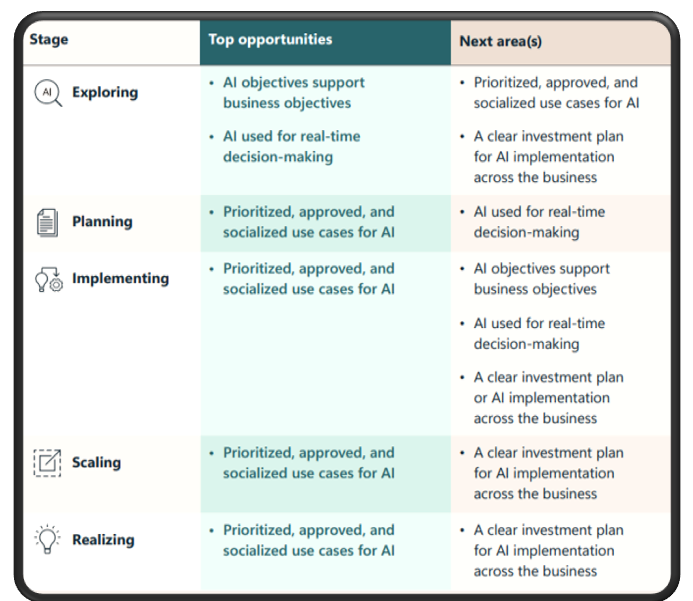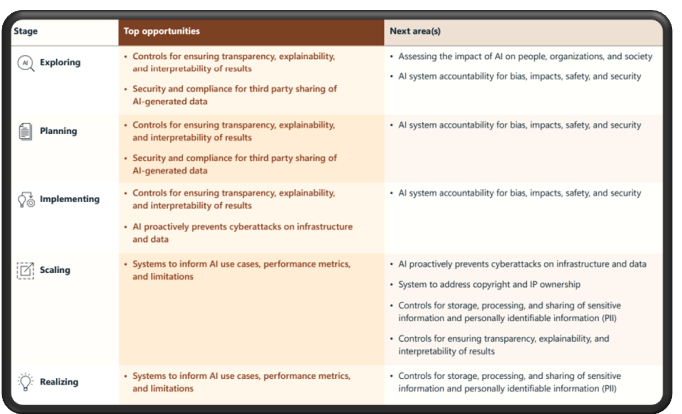Best Practices for Adopting Microsoft Copilot in the Dynamics 365 Environment
Microsoft Copilot allows organizations to bring AI-driven assistance directly into the Dynamics 365 environment. To successfully adopt, IT Industries must prepare a well-thought-out strategic plan that aligns technology with business objectives and carefully consider how to prepare both users and the infrastructure.
This blog discusses essential steps that both midsize and large enterprises should consider to strategically implement Copilot within their Dynamics 365 environment. The Microsoft AI Strategy Roadmap figure below illustrates the business strategy for each stage with its next area of action.

Reference: Microsoft Strategy Roadmap
Industries that follow the essential steps will maximize the benefits of Copilot while keeping adoption smooth and impactful. Let’s go through each of the essential steps.
- Conduct a Comprehensive Needs Assessment
Analyze your organization’s
- Workflows,
- Processes, and
- Pain Points
Identify where AI assistance can deliver the most value: improved customer service response times, automating routine tasks, or enhancing data-driven decision-making.
This is the most time-consuming activity, but it ensures that Copilot’s implementation targets
- Meaningful areas,
- Maximizing ROI and
- User engagement
- Align Priorities and Set Clear Objectives
The next important activity is to define and prioritize goals for Copilot’s adoption. The organization/industries should establish success criteria such as
- Productivity gains,
- User adoption rates, or
- Reduction in errors
The above measurable objectives help to guide deployment phases and provide benchmarks to evaluate effectiveness.
- Prepare the Microsoft 365 with the Dynamics 365 Environment and Governance Framework
Ensure your Dynamics 365 and Microsoft 365 environments are ready. Review user roles, data governance policies, and compliance requirements. Establish security measures that protect sensitive information while enabling Copilot to operate effectively on relevant data. A governance framework is vital for the sustainable, compliant use of AI.

Reference: Microsoft Strategy Roadmap
-
Build Awareness and Provide Training
Inform stakeholders and end-users about the capabilities and benefits of Copilot. Conduct workshops, demos, and ongoing training sessions on real-world use cases. Empowering users to comfortably leverage AI assistance accelerates adoption and reduces resistance.
- Implement Pilot Programs and Collect Feedback
A phased rollout with pilot programs allows you to validate Copilot’s impact in controlled settings. User feedback and usage analytics are gathered to identify challenges, address issues, and refine training materials. This iterative approach strengthens organizational confidence and readiness for full-scale adoption.
- Establish Center of Excellence (CoE) for Ongoing Support and Continuous Improvement
Adoption doesn’t end at launch. Set up a Center of Excellence or a support team dedicated to Copilot. Continuously monitor usage, update governance policies as needed, and share best practices to maintain momentum and ensure Copilot evolves in alignment with organizational needs.
- Communicate Transparently and Address Change Management
Managing change is crucial. Communicate clearly how Copilot enhances productivity rather than replacing jobs. Share success stories early and often to build trust. Engage stakeholders at every level to address concerns, ensuring everyone feels included and supported during the transition.
- Build a Community of Champions
Empower enthusiastic early adopters to become Copilot champions within teams. These users can share best practices, answer peers’ questions, and promote creative use cases. Building this community drives adoption momentum and fosters a collaborative learning environment.
Conclusion
Successfully adopting Microsoft Copilot in your Dynamics 365 environment is a journey that combines technology readiness, smart deployment, and human-centered support. The key measures traversing from analysis of the organization’s comprehensive needs, then establishing a Center of Excellence and fostering user communities, organizations can unlock the full potential of AI-powered assistance.
With AI-powered Microsoft Copilot, an organization’s productivity and innovation rise.
In the upcoming blog post, we’ll discuss the challenges in adopting Copilot in the Dynamics 365 ecosystem. Stay tuned.

is a Senior Architect at Product & Digital Engineering Services at Happiest Minds. With extensive experience of 19+ years in Microsoft Technology and expertise in Microsoft Dynamics 365, Power Platform, and Solution Designing, he specializes in software development, project management, and quality assurance. He is passionate about bridging the gap between business processes, methodology, and technology. He has worked on multiple projects spanning domains like Finance, Banking, Telecom, Insurance, HR, Sports, Automobile, etc.



